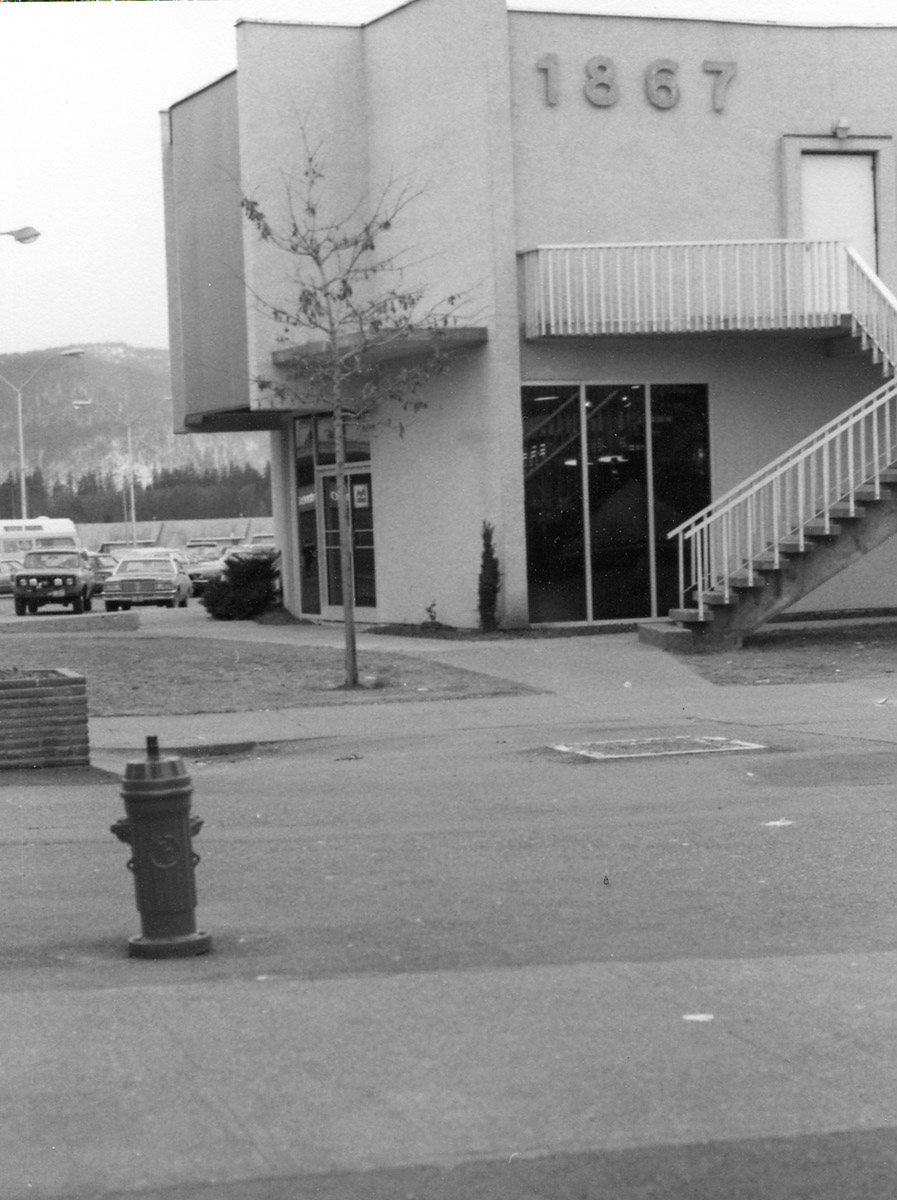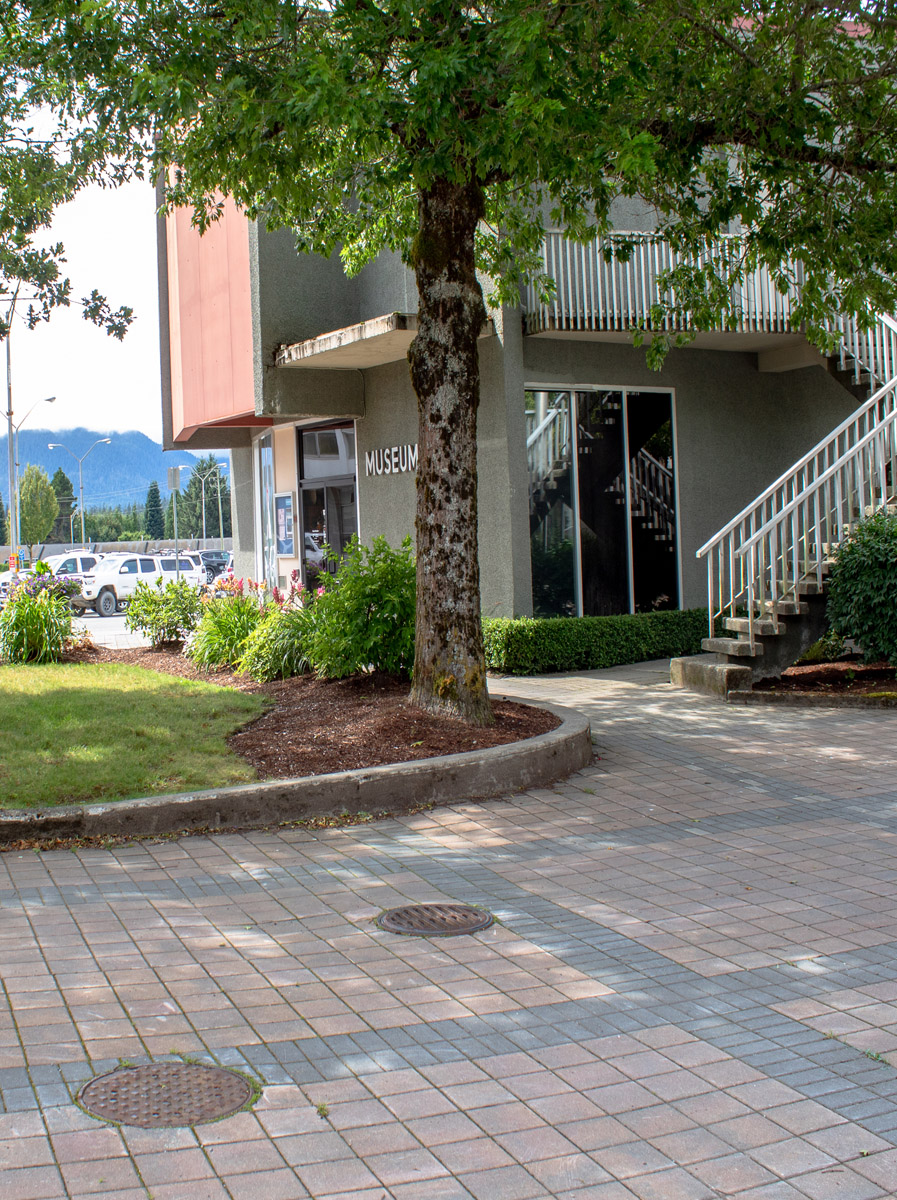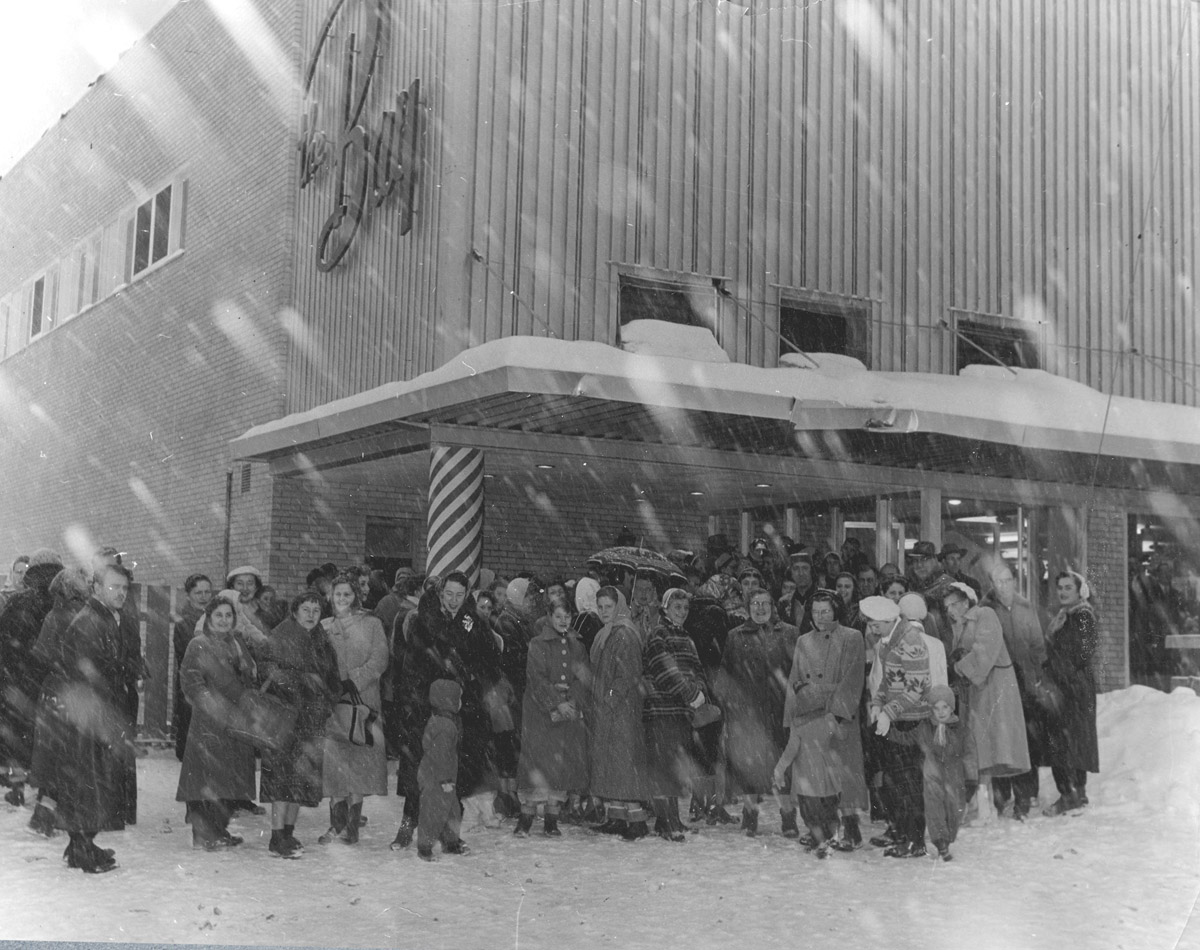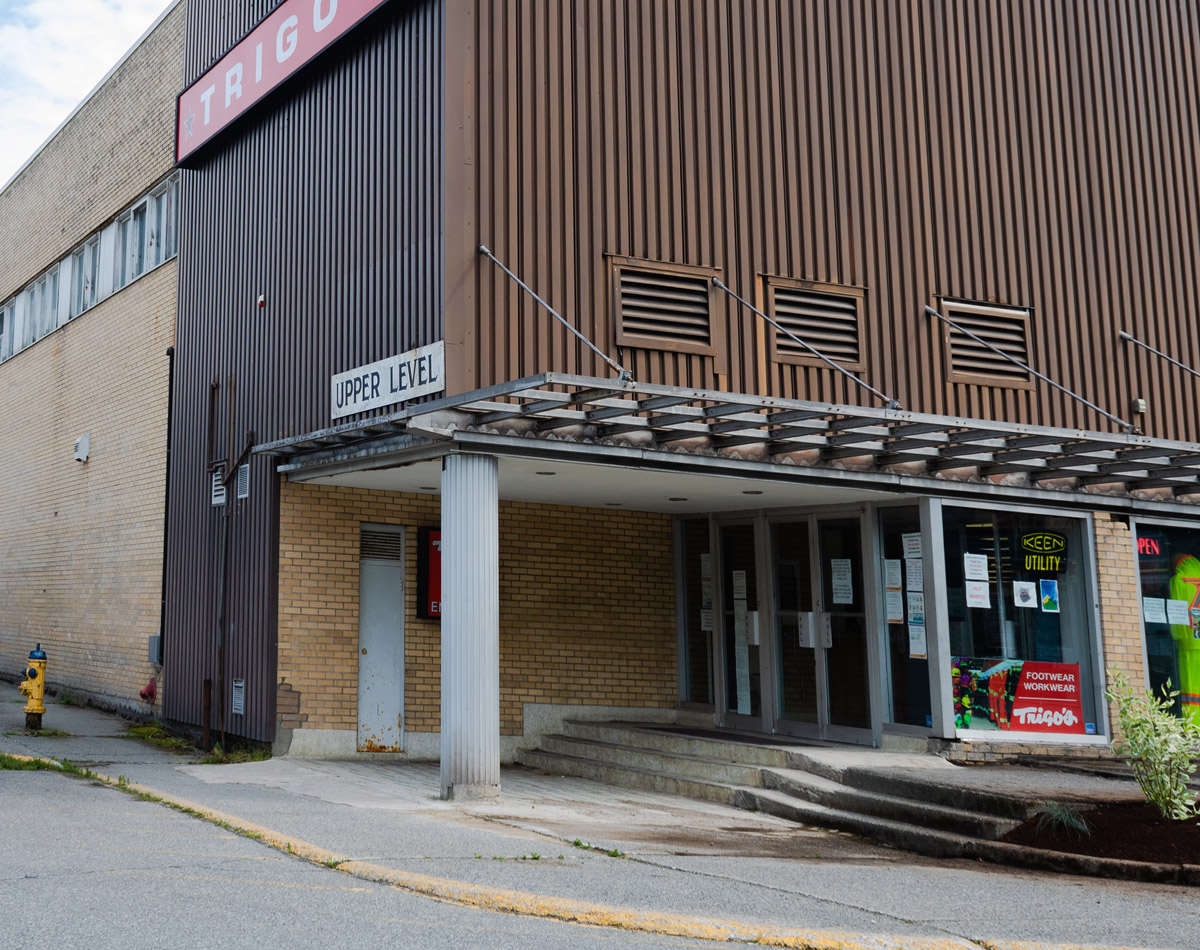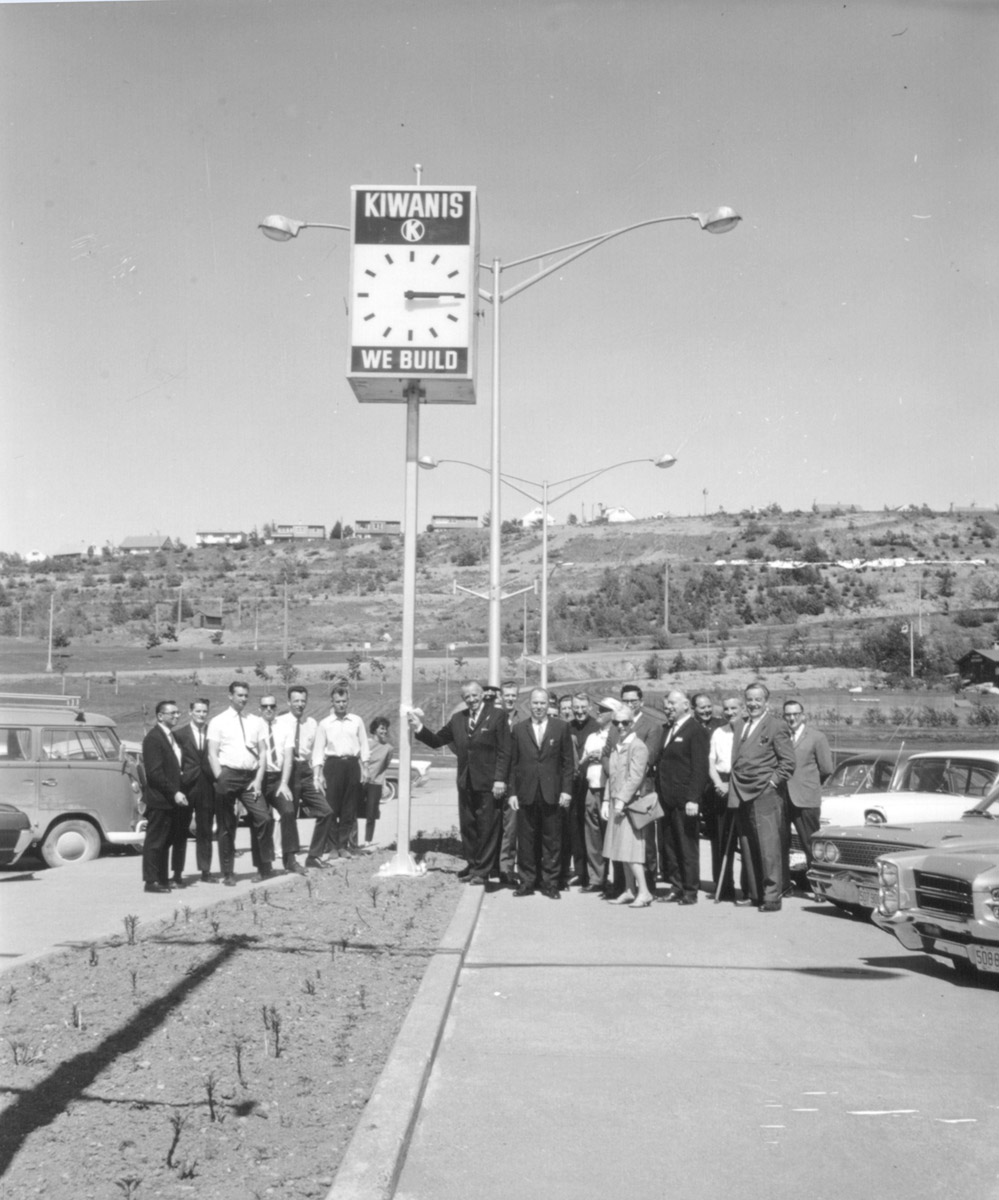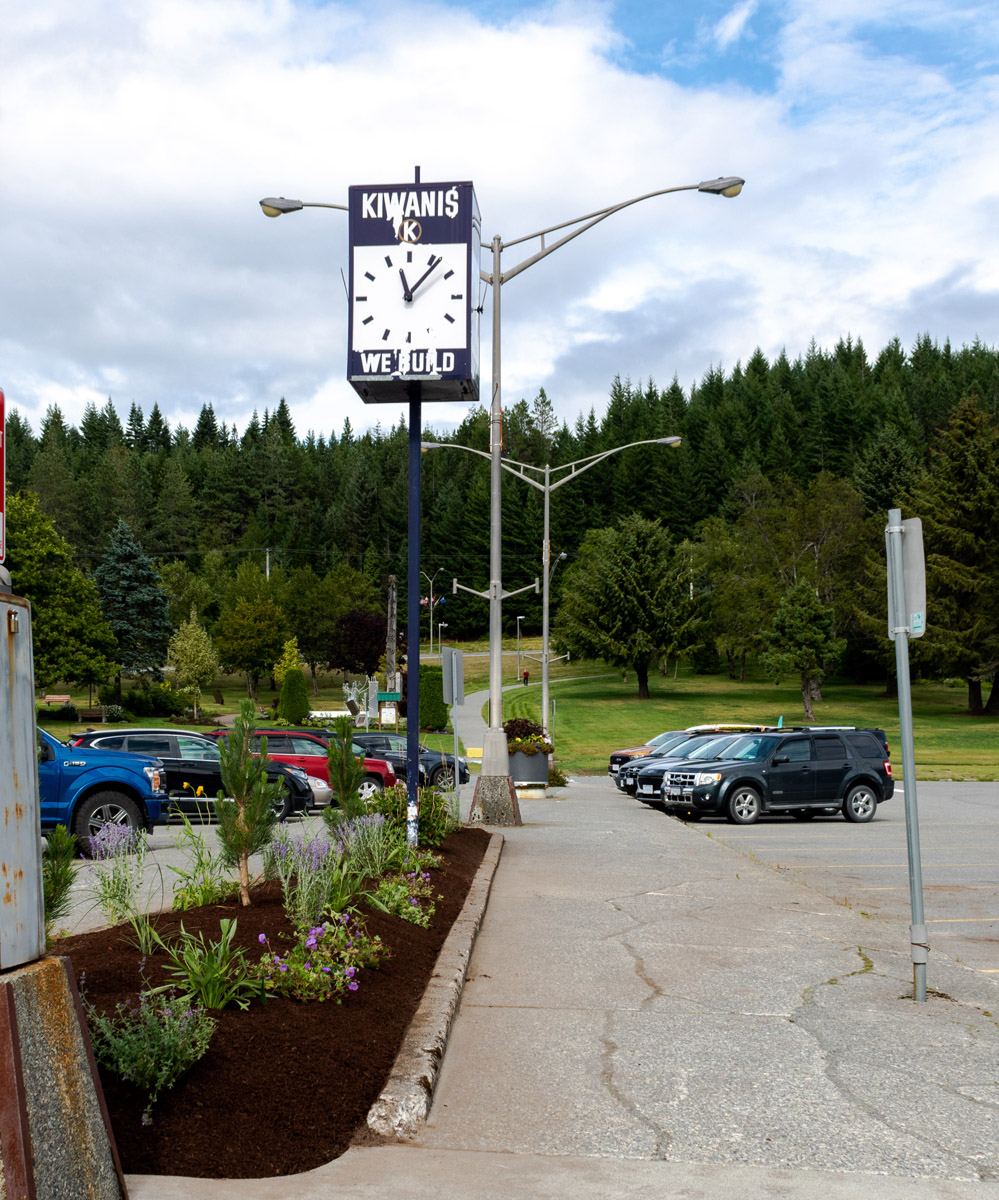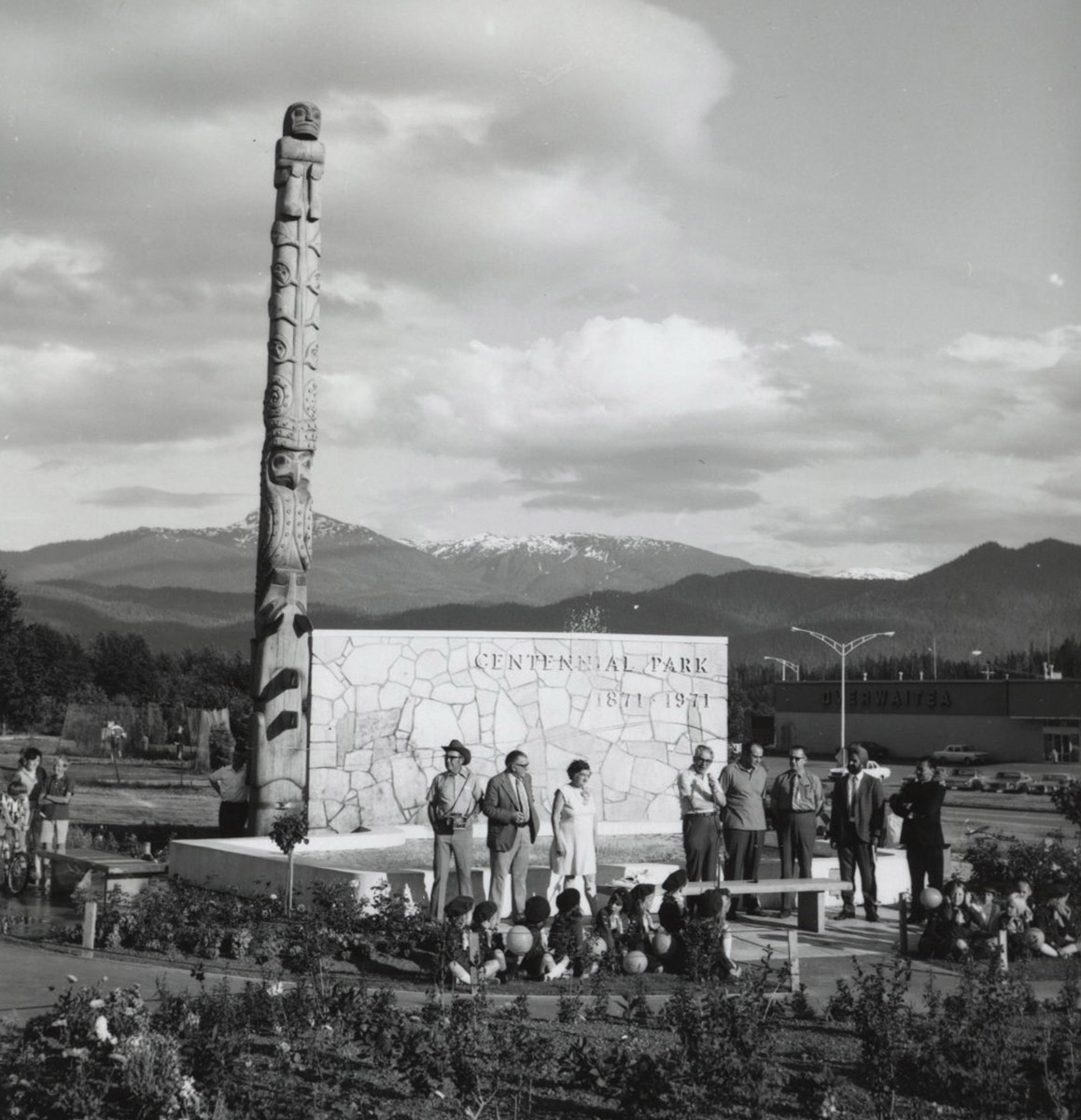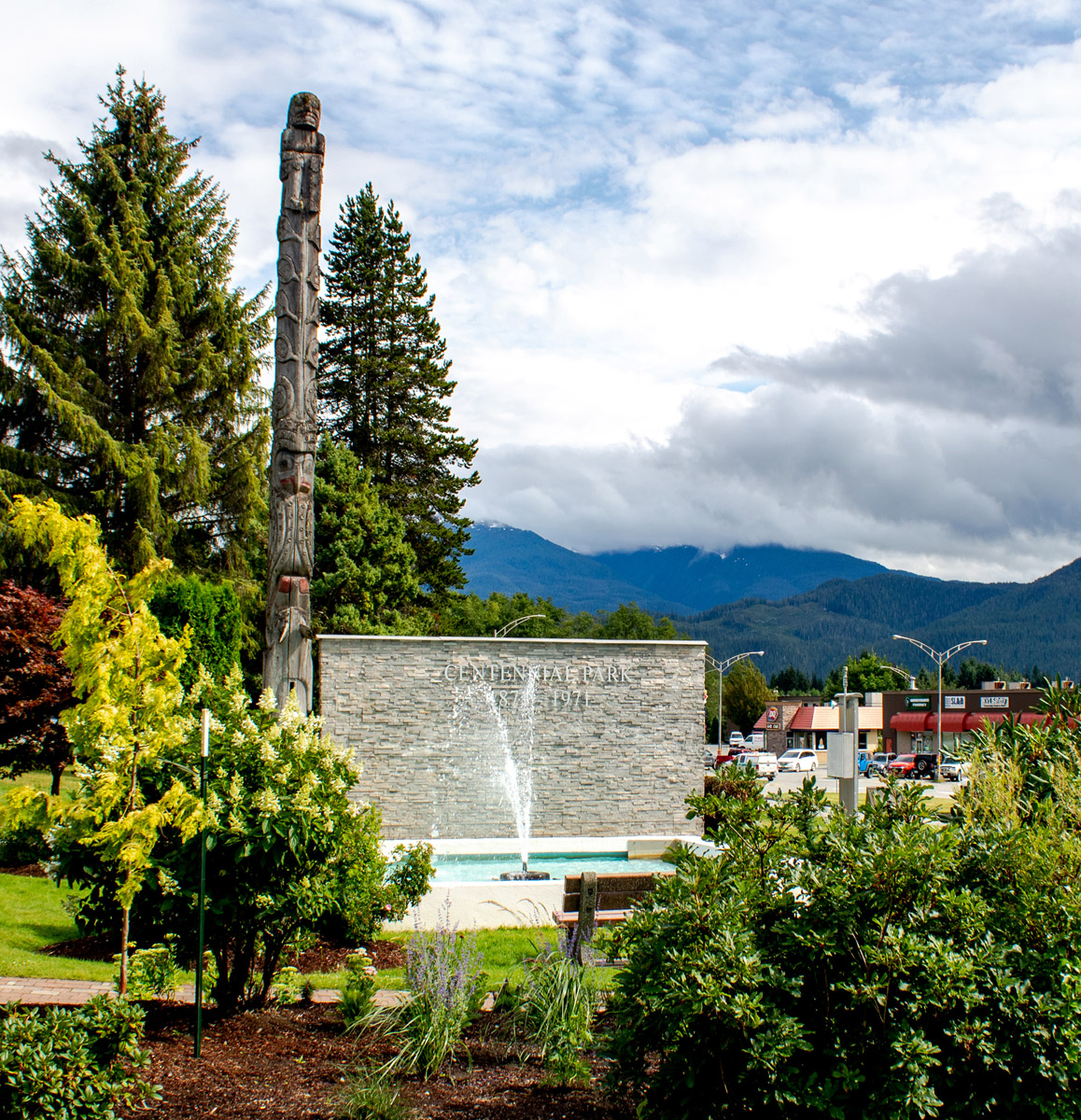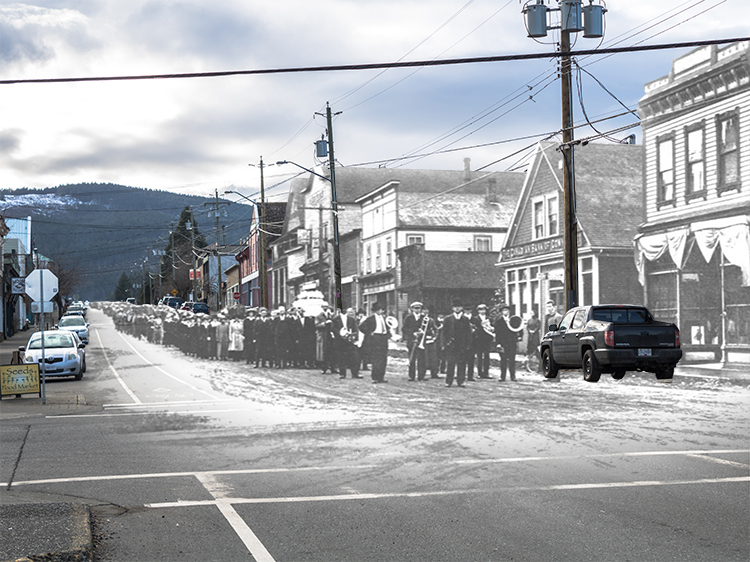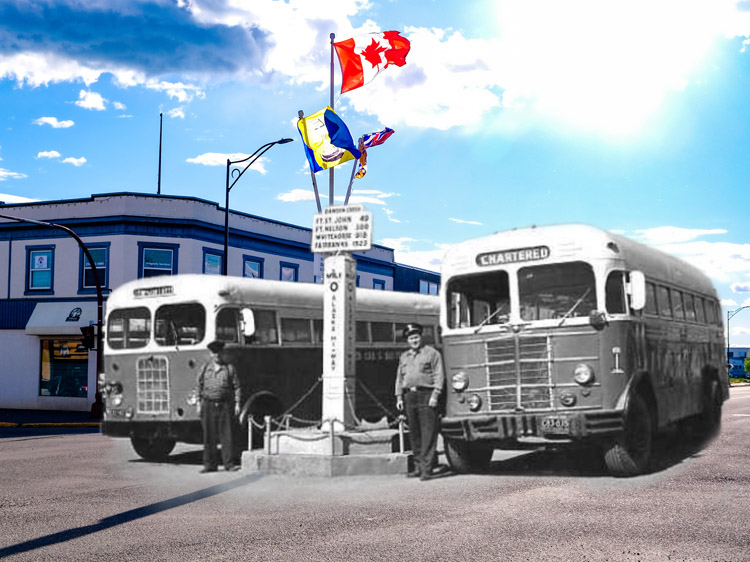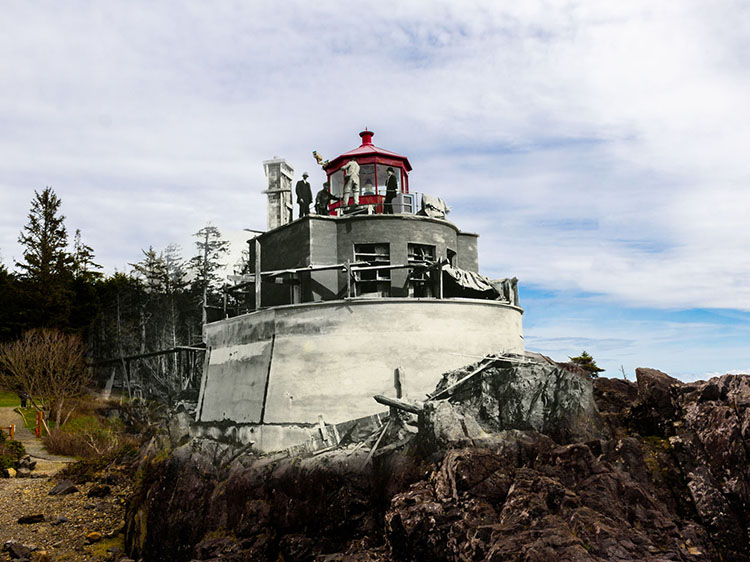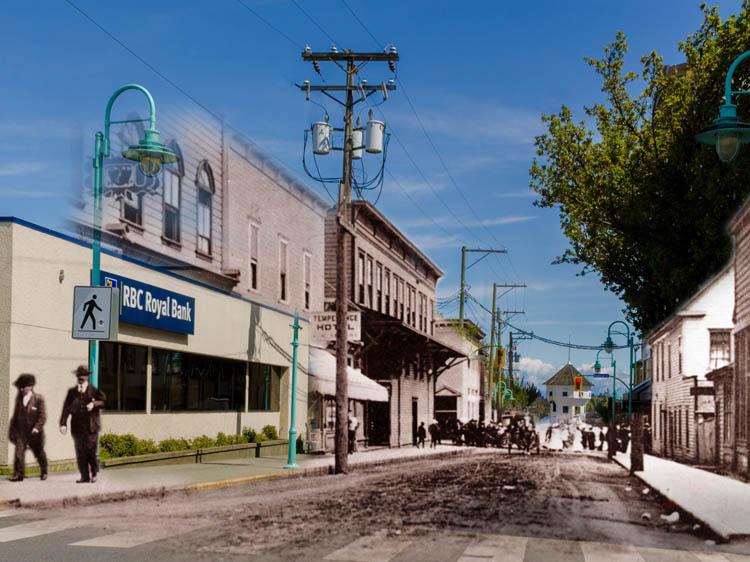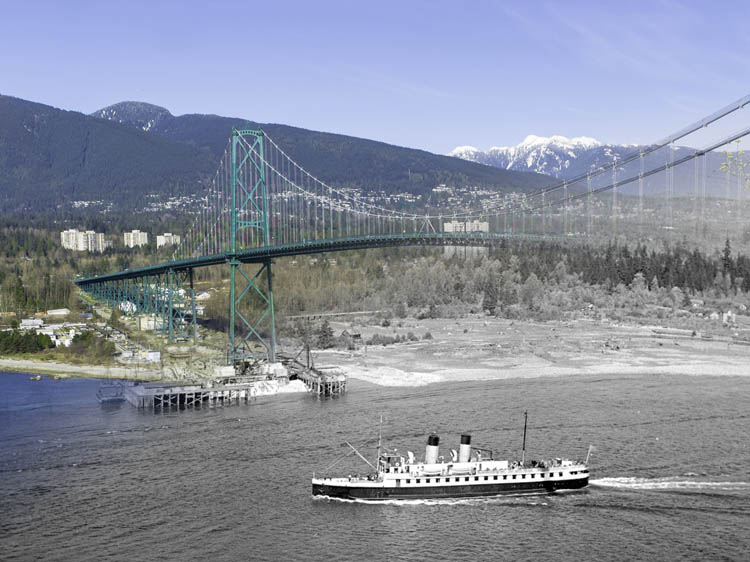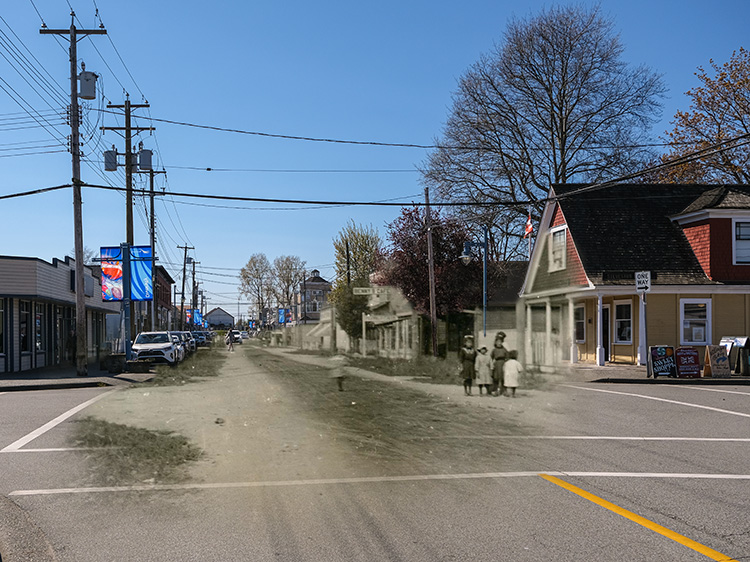Walking Tour
Kitimat's City Centre
Building Community
By Natalie Dunsmuir
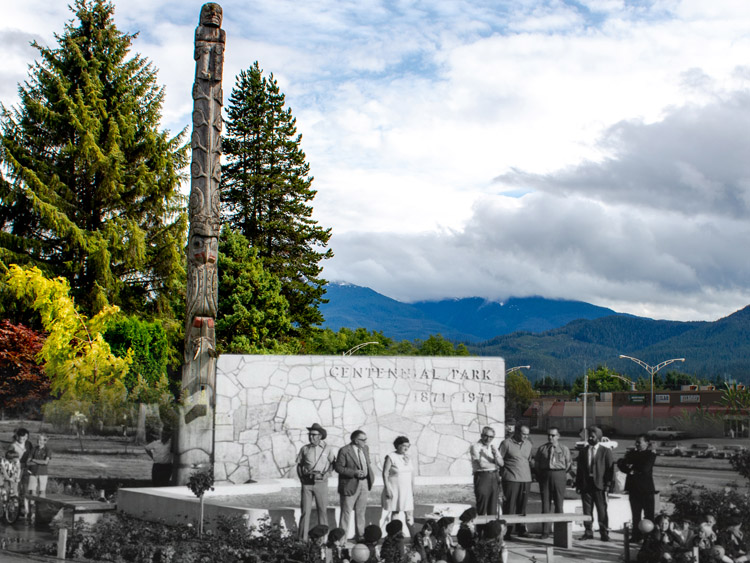
As BC's first fully planned town, Kitimat had many expectations to live up to. For the Aluminum Company of Canada, Alcan for short, the most important aspect of the new town was a family-friendly, welcoming nature to attract and retain workers. For the city planners, the town was a blank canvas on which to enact long held dreams and philosophies of town planning. And for Kitimat's new residents, it was a place to build a life. All of these hopes came together in the construction of City Centre, located as it was at the core of the community.
Kitimat's unique city plan centred around a commerce hub where residents of all of the neighbourhoods could gather. This hub would have everything anyone would need: a grocery store, department store, health care centre, movie theatre, library, government building, and a museum. Civic buildings such as a library, museum, and federal government building would be signs of a stable, well established community.
In this short tour, we will dive into the planning principles that went into the design for City Centre and look at how the Centre has changed over the years. At stop one, outside of the Kitimat Museum, we will identify why this location was chosen for the Centre and how the shopping complex differed from the Service Centre across the river. From there, walk up the stairs behind the Kitimat Museum & Archives to reach the other side of the City Centre Mall. Or, head inside to the elevator and cross through the mall to the far parking lot. At stop two, outside of the old Hudson's Bay Company Building, we will learn about the Centre's original design and the original businesses and amenities that comprised it.
To reach stop three, cross part of the parking lot and stand at the base of the Kiwanis Clock. Here, learn about the community clubs and groups that built Kitimat together. Our fourth and final stop on the tour takes us to Centennial Park, where we look at community spirit in Kitimat and the many events and social get-togethers that were so essential to life in a small town.
This project was created in partnership with the Kitimat Museum and Archives.
1. The City Centre Takes Shape
1979
This photo shows the Kitimat Museum & Archives shortly after its construction. The Museum opened in 1969 to celebrate Canada's Centennial, joining a diverse selection of commercial spaces located in the City Centre. Centennial funds were committed in 1967 by the Municipal Council. The Museum celebrates Kitimat's history, both before the coming of Alcan and after, with historical artifacts, informational panels, and natural history collections. The City Centre is the hub for Kitimat, and facilities like the Museum are a downtown attraction for residents to visit.
* * *
Locating the downtown here was one of the ways in which the city planners increased the prominence and importance of City Centre as Kitimat’s hub. They also made sure to build the City Centre before any of the neighbourhood centres, since they were worried that if they constructed the Nechako Centre first, it would instead grow to be the biggest centre in town as residents got used to relying upon it. This would "warp" the neighbourhood and throw the entire community plan into chaos.2
"Underdevelop the neighbourhood centre to start with, start your main centre at once with some of the shops that ultimately are needed in the local centre, form the habit of people going to the main centre; and only, a good deal later, when that is really on its feet, go back and round out the first local centre."3
The Centre would meet people’s household and personal needs. Business operations supplying industry and needing space would be located at the Service Centre across the river, closer to industry and away from downtown. In an effort by planners to keep industry and residential separate in the town plan, the highway was planned to come in at Service Centre, thus avoiding commercial vehicle traffic entering the residential part of town. B.C. Highways did not follow this plan, instead constructing the highway so that all traffic would pass through town before heading to Service Centre and the industrial sites.
Service Centre businesses included trucking, mechanics, laundries, bakeries, warehouses, and freight interchange yards, all "tucked away out of sight."4 Over the years, Service Centre did well, serving its purpose as an industrial business centre. It thrives today. As long as there are industries to supply, there will be businesses at Service Centre.
2. Businesses and Amenities in City Centre
1956
In this photograph, the new Hudson's Bay Company store opens in Kitimat on a snowy winter day in 1957. The opening was a big celebratory event for Kitimat residents. The Bay flew orchids to Kitimat from Hawaii to distribute to the women attending. During smelter and town construction, the Bay had operated a store at Smeltersite, the temporary community located beside the smelter.
* * *
In 1974, the shopping centre was enlarged with a third floor and additional shops and was enclosed—a trend at the time to protect shoppers from the weather.
The downtown orientation was neither understood nor popular. Kitimat residents have long lamented the town's lack of a traditional main street, where shops line the road rather than garden space. "I think the only thing that really... made it more awkward and more difficult was having City Centre the way it was, which was [that] there was no main street ..."1
Despite this criticism, City Centre has done well. Popular early businesses included the Bay, Shop-Easy, and Helen's Cafe, a busy community gathering spot. The cafe originally opened in Smeltersite beside the aluminum smelter in 1952 but moved to City Centre in 1957. It remained open until 1970.2
3. A Place to Gather
1967
The Kiwanis Clock in City Centre, pictured here, has long been a Kitimat landmark. It was first unveiled on June 3, 1967, as part of a Canada Centennial Year project by the Kiwanis Club of Kitimat and District of Kitimat. This photo shows the official unveiling. A group of men and a few women, all dressed formally, gather around the clock for a picture. Mayor Sam Lindsay holds onto the ribbon tied around the clock pole. “Kiwanis - We Build,” white lettering on the clock face, identifies the service of Kiwanis to Kitimat. Kitimat's City Centre was not just a place for shopping but also a place to gather and connect. The cultural function of the Centre was as important as its commercial purposes.
* * *
City Centre was meant, in part, to solve this problem. It was designed with an Italian piazza in mind, where shops would be broken up by community and public buildings.2 A museum was worked into Kitimat's original Master Plan, along with two 800-seat theatres, though these were never built. The library was also meant to be built here, although it was originally established first at the Nechako Centre and only moved to City Centre later. This mix of culture and entertainment was intended to make City Centre a more enjoyable place to be and to lift the monotony of remote life.
Government and commercial office space also featured in the city plan, and recreation became a key part of the area. In Kitimat’s first years, a portion of the City Centre parking lot was converted each winter into a giant skating rink, and kids and their parents flocked to the City Centre on the weekends and holidays. Later, Kitimat Ice Rink with its distinctive curved roof officially opened. It was the town’s first enclosed sheet of ice.
4. Kitimat's Community Spirit
1971
This image shows Centennial Park, which for years has hosted public events and celebrations. Pictured here, a group of Kitimat Brownies, seated in a row on the ground with dignitaries standing behind them, are arranged in front of a park sign, a fountain, and a totem pole, at the official opening of the Park, July 20, 1971.
City Centre was an important place for community gathering in Kitimat's early years. The residents of Kitimat formed robust social clubs and hosted celebrations, competitions, and parades. Kitimat was home to many service clubs and community organizations; groups like the Kiwanis Club lessened the isolation of living in such a remote location and provided valuable services for the community. Residents were able to help build Kitimat.
* * *
"You have to make your own entertainment in places like that."1
Early Kitimat was filled with dances, sports competitions, concerts, parades, and specialized clubs. There was a Brush and Pallet Club, a Yacht Club, a Rod and Gun Club, a Pipe Band, and a Little Symphony, among other organizations. Everyone had a hobby and a group to be part of. Service clubs such as the Kiwanis Club, the Kinsmen, the Rotary Club, and the Elks formed in an effort to improve the town. There was a branch of the Royal Canadian Legion, a Professional Women's Club, and the Nechako Toastmasters. The Fine Arts Association brought travelling art shows to the town from across Canada, and the Kitimat Works Sports Association formed in 1956 and began hosting competitions in curling, softball, darts, bowling, and hockey. Youth groups such as Boy Scouts, Girl Guides, and Cadets kept children occupied and involved.
"That was the beauty of the early days, if you wanted something like that [Rod & Gun Club] everyone chipped in and you built it yourselves. And the result was that the Rod and Gun Club truly was looked after well because... you were kind of like an owner."2
Annual events in town included the popular Dominion Day celebrations (now Canada Day), during which large parades would move through town. Delta King Days, taking place on the May Long Weekend each year, involved the entire community with a host of events, including raft racing on the Kitimat River. Each Christmas beginning in 1958, a Christmas light contest brightened Kitimat's neighbourhoods.
One popular event was the Miss Kitimat Pageant, originally sponsored by the Elks Club. The first pageant took place in 1954, and it became an annual tradition after that. The winner would travel to Vancouver as Miss Kitimat to represent the town at Vancouver's PNE.
With all the activity, life certainly wasn't dull in Kitimat. The town planners' fears did not come true: Kitimat in the early years was neither lonely nor monotonous, though this may have been due less to the extremely detailed town planning and more to the ingenuity and community spirit of its residents. As one Alcan engineer reflected: "Institutions, plans, and buildings are only the framework of a community. It was the townspeople, not the planners or builders, who made Kitimat."3
Endnotes
1. The City Centre Takes Shape
1. "Kitimat: A New City." Special Reprint from the Architectural Forum, 1954.
2. "Kitimat: A New City."
3. "Kitimat: A New City."
4. Kendrick, John. People of the Snow: The Story of Kitimat. Toronto: NC Press Limited, 1987. 133.
2. Businesses and Amenities in City Centre
1. "Living Landscapes: Memories of the Project." Royal BC Museum. https://royalbcmuseum.bc.ca/exhibits/living-landscapes/northwest/kitimat/memories.html.
2. Beck, Janice. Three Towns: A History of Kitimat. Kitimat Centennial Museum Association, 1983. 62.
3. A Place to Gather
1. "Kitimat: A New City."
2. "Kitimat: A New City."
4. Kitimat's Community Spirit
1. "Living Landscapes: Memories of the Project."
2. Living Landscapes: Memories of the Project."
3. Kendrick, John. 142.
Bibliography
Beck, Janice. Three Towns: A History of Kitimat. Kitimat Centennial Museum Association, 1983.
Kendrick, John. People of the Snow: The Story of Kitimat. Toronto: NC Press Limited, 1987.
"Kitimat: A New City." Special Reprint from the Architectural Forum, 1954.\
"Living Landscapes: Memories of the Project." Royal BC Museum. https://royalbcmuseum.bc.ca/exhibits/living-landscapes/northwest/kitimat/memories.html.




